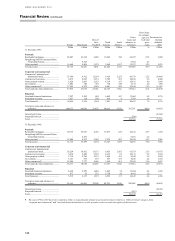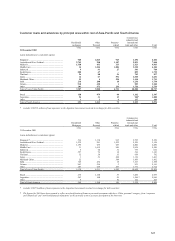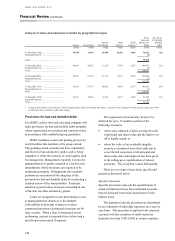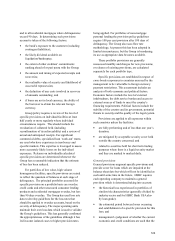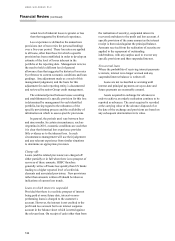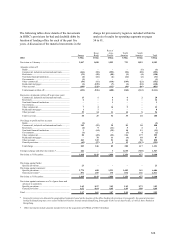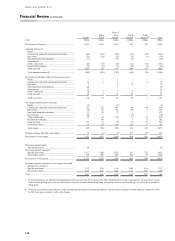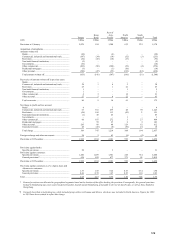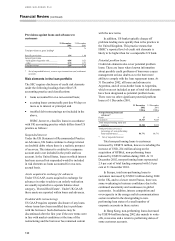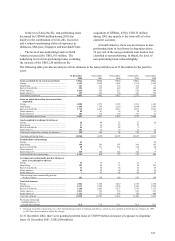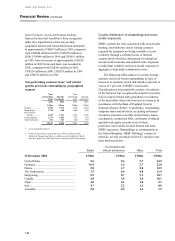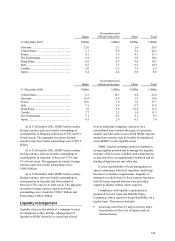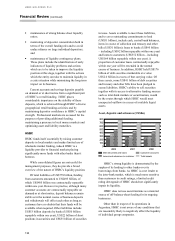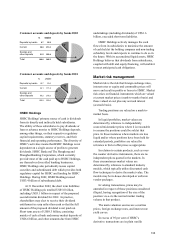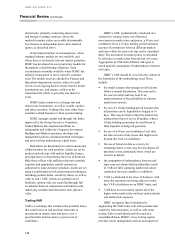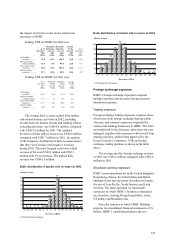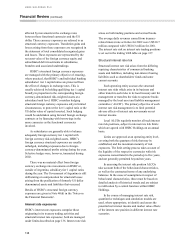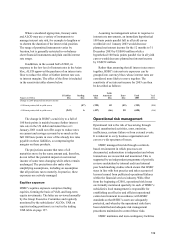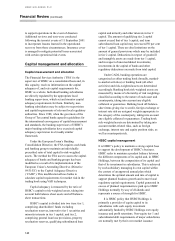HSBC 2002 Annual Report Download - page 132
Download and view the complete annual report
Please find page 132 of the 2002 HSBC annual report below. You can navigate through the pages in the report by either clicking on the pages listed below, or by using the keyword search tool below to find specific information within the annual report.
HSBC HOLDINGS PLC
Financial Review (continued)
130
Provisions against loans and advances to
customers
31 December 31 Decembe
r
2002 2001
%%
Total provisions to gross lending*
Specific provisions............................. 1.94 1.90
General provisions
- held against Argentine risk .............. 0.04 0.21
- other ................................................ 0.70 0.71
Total provisions ................................. 2.68 2.82
* Net of suspended interest, reverse repo transactions and settlement
accounts.
Risk elements in the loan portfolio
The SEC requires disclosure of credit risk elements
under the following headings that reflect US
accounting practice and classifications:
• loans accounted for on a non-accrual basis;
• accruing loans contractually past due 90 days or
more as to interest or principal; and
• troubled debt restructurings not included in the
above.
HSBC, however, classifies loans in accordance
with UK accounting practice which differs from US
practice as follows:
Suspended interest
Under the UK Statement of Recommended Practice
on Advances, UK banks continue to charge interest
on doubtful debts where there is a realistic prospect
of recovery. This interest is credited to a suspense
account and is not included in the profit and loss
account. In the United States, loans on which interest
has been accrued but suspended would be included
in risk elements as loans accounted for on a non-
accrual basis.
Assets acquired in exchange for advances
Under US GAAP, assets acquired in exchange for
advances in order to achieve an orderly realisation
are usually reported in a separate balance sheet
category, ‘Owned Real Estate’ . Under UK GAAP,
these assets are reported within loans and advances.
Troubled debt restructurings
US GAAP requires separate disclosure of any loans
whose terms have been modified due to problems
with the borrower. Such disclosures may be
discontinued after the first year if the new terms were
in line with market conditions at the time of the
restructuring and the borrower has remained current
with the new terms.
In addition, US banks typically charge off
problem lending more quickly than is the practice in
the United Kingdom. This practice means that
HSBC’s reported level of credit risk elements is
likely to be higher than for a comparable US bank.
Potential problem loans
Credit risk elements also cover potential problem
loans. These are loans where known information
about possible credit problems of borrowers causes
management serious doubts as to the borrowers’
ability to comply with the loan repayment terms. At
31 December 2002, all loans and advances in
Argentina, and all cross-border loans to Argentina,
which were not included as part of total risk elements
have been designated as potential problem loans.
There were no other significant potential problem
loans at 31 December 2001.
31 December 31 Decembe
r
2002 2001
US$m US$
m
Non-performing loans and
advances*
Banks.................................... 17 9
Customers............................. 10,523 9,649
Total non-performing loans and
advances .......................... 10,540 9,658
Total provisions cover as a
percentage of non-performing
loans and advances .......... 86.7% 84.7%
*Net of suspended interest.
Total non-performing loans to customers
increased by US$874 million, however excluding the
increase of US$1,224 million arising on the
acquisition of GFBital, non-performing loans
reduced by US$350 million during 2002. At 31
December 2002, non-performing loans represented
2.9 per cent of total lending compared with 3.0 per
cent at 31 December 2001.
In Europe, total non-performing loans to
customers increased by US$813 million during 2002.
In the UK, and to a lesser extent France, there was
some weakening in business confidence due to the
continued uncertainty and weaknesses in global
economies. In addition, intense competition and
over-capacity in the energy and telecommunications
sectors resulted in the downgrading to non-
performing loan status of a small number of
corporate accounts in these sectors.
In Hong Kong, non-performing loans decreased
by US$304 million during 2002 due mainly to write-
offs, recoveries and a return to performing status of
some customer accounts.


